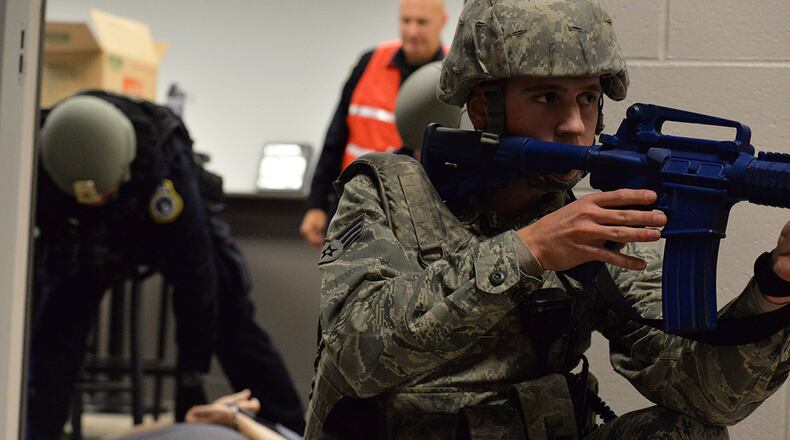Wright-Patterson Air Force Base officials want the base populace to not only be informed but also ready to quickly, safely and effectively respond should an active-shooter incident arise here.
The U.S. Air Force defines an active shooter as “an individual actively engaged in killing or attempting to kill people, most often in populated areas. In most cases, active shooters use firearms, and there is no pattern or method to their selection of victims. In some cases, active shooters use improvised explosive devices to create additional victims and to impede first responders.”
According to a recent Federal Bureau of Investigation report, there were 277 active-shooter incidents in the United States between 2000 and 2018. With more than 2,400 casualties, including nearly 900 killed during that time frame, the numbers are sobering. The report also notes that, historically, the number of active shooter instances is trending upward.
To better prepare personnel to respond to an active-shooter, base-wide exercises often include an active-shooter drill.
With the drill, as with an actual incident, an attack warning siren will sound, in conjunction with the lockdown announcement projected over the base’s Giant Voice system. The attack warning is a 3-to 5-minute wavering tone and should not be confused with the disaster warning, which is a 3- to 5-minute steady tone.
An attack warning alarm indicates that an attack/hostile act is imminent or in progress, and appropriate response should be immediate.
Situations involving active shooters can be terrifying and entirely unpredictable. Law enforcement will immediately respond to the shooter, but actions taken by individuals in harm’s way before police arrive can save lives. Individuals must be prepared to act quickly. If ever in this situation, remember your actions should be to run, hide and, as a last resort, fight.
If the shooter is inside your building, run to the closest exit or nearest room (if safe to do so) and lock or barricade the door. Leave all belongings behind as this may hinder the ability to escape quickly. Stay away from windows, stay down on the floor, and remain silent. Remain there until an “all clear” is heard from first responders.
If caught outside during an active shooter, immediately seek cover and concealment. Try to stay on the ground and remain there until you hear an “all clear” from first responders.
As a last resort, use any means available to incapacitate the shooter by fighting back.
When safe to do so, dial 9-1-1 from any base phone, or 937-257-9111 from any cellular phone. Keep in mind that phone lines will be busy, but when able to get through, be prepared to give information, such as your name and location, the number of people with you, the location of the shooter, number of shooters, physical description of the shooter(s), number and type of weapon(s) held by the shooter(s) and the approximate number of victims and their injuries.
Once law enforcement personnel arrive and eliminate the threat, remain in place, listen for the “all clear” to be given, remain calm, do not yell or make any sudden movements, keep hands visible and follow all instructions given by first responders. This is for your safety.
When the incident is over, be prepared to give investigators and Air Force Office of Special Investigations any pertinent information you may have, assist in taking accountability of your co-workers, and seek medical or mental health treatment as necessary.
Finally, remember that the facility where the incident occurred will be treated as a crime scene. You will not be permitted to reenter until the investigation is complete.
Active-shooter incidents are tragic and happen very quickly. Being prepared to take appropriate actions can save your life and those around you. Units may work with their antiterrorism representatives (ATR) or the Installation Antiterrorism Office to schedule local training or in-house active shooter drills. If you need further direction regarding active-shooter actions, drills or training, contact your unit ATR or the Installation Antiterrorism Office at 937-247-8473 or 937-904-2970.
About the Author
